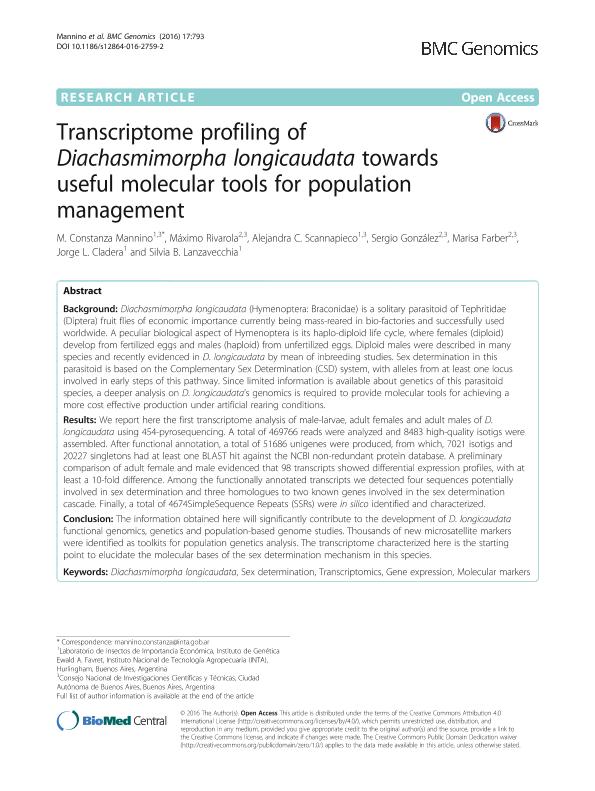Artículo
Transcriptome profiling of Diachasmimorpha longicaudata towards useful molecular tools for population management
Mannino, Maria Constanza ; Rivarola, Maximo Lisandro
; Rivarola, Maximo Lisandro ; Scannapieco, Alejandra Carla
; Scannapieco, Alejandra Carla ; González, Sergio Alberto
; González, Sergio Alberto ; Farber, Marisa Diana
; Farber, Marisa Diana ; Cladera, Jorge Luis; Lanzavecchia, Silvia Beatriz
; Cladera, Jorge Luis; Lanzavecchia, Silvia Beatriz
 ; Rivarola, Maximo Lisandro
; Rivarola, Maximo Lisandro ; Scannapieco, Alejandra Carla
; Scannapieco, Alejandra Carla ; González, Sergio Alberto
; González, Sergio Alberto ; Farber, Marisa Diana
; Farber, Marisa Diana ; Cladera, Jorge Luis; Lanzavecchia, Silvia Beatriz
; Cladera, Jorge Luis; Lanzavecchia, Silvia Beatriz
Fecha de publicación:
10/2016
Editorial:
BioMed Central
Revista:
BMC Genomics
ISSN:
1471-2164
Idioma:
Inglés
Tipo de recurso:
Artículo publicado
Clasificación temática:
Resumen
Background: Diachasmimorpha longicaudata (Hymenoptera: Braconidae) is a solitary parasitoid of Tephritidae (Diptera) fruit flies of economic importance currently being mass-reared in bio-factories and successfully used worldwide. A peculiar biological aspect of Hymenoptera is its haplo-diploid life cycle, where females (diploid) develop from fertilized eggs and males (haploid) from unfertilized eggs. Diploid males were described in many species and recently evidenced in D. longicaudata by mean of inbreeding studies. Sex determination in this parasitoid is based on the Complementary Sex Determination (CSD) system, with alleles from at least one locus involved in early steps of this pathway. Since limited information is available about genetics of this parasitoid species, a deeper analysis on D. longicaudata's genomics is required to provide molecular tools for achieving a more cost effective production under artificial rearing conditions. Results: We report here the first transcriptome analysis of male-larvae, adult females and adult males of D. longicaudata using 454-pyrosequencing. A total of 469766 reads were analyzed and 8483 high-quality isotigs were assembled. After functional annotation, a total of 51686 unigenes were produced, from which, 7021 isotigs and 20227 singletons had at least one BLAST hit against the NCBI non-redundant protein database. A preliminary comparison of adult female and male evidenced that 98 transcripts showed differential expression profiles, with at least a 10-fold difference. Among the functionally annotated transcripts we detected four sequences potentially involved in sex determination and three homologues to two known genes involved in the sex determination cascade. Finally, a total of 4674SimpleSequence Repeats (SSRs) were in silico identified and characterized. Conclusion: The information obtained here will significantly contribute to the development of D. longicaudata functional genomics, genetics and population-based genome studies. Thousands of new microsatellite markers were identified as toolkits for population genetics analysis. The transcriptome characterized here is the starting point to elucidate the molecular bases of the sex determination mechanism in this species.
Archivos asociados
Licencia
Identificadores
Colecciones
Articulos(SEDE CENTRAL)
Articulos de SEDE CENTRAL
Articulos de SEDE CENTRAL
Citación
Mannino, Maria Constanza; Rivarola, Maximo Lisandro; Scannapieco, Alejandra Carla; González, Sergio Alberto; Farber, Marisa Diana; et al.; Transcriptome profiling of Diachasmimorpha longicaudata towards useful molecular tools for population management; BioMed Central; BMC Genomics; 17; 1; 10-2016; 1-13
Compartir
Altmétricas



